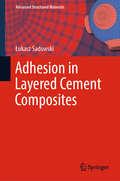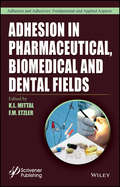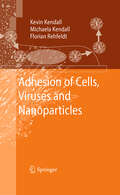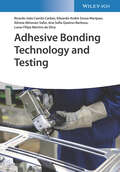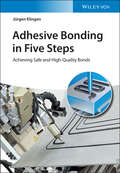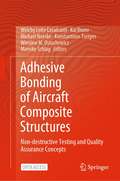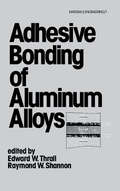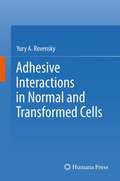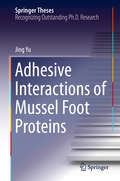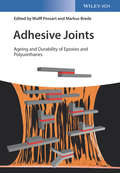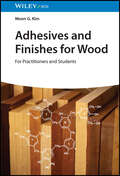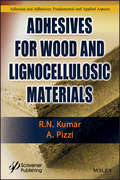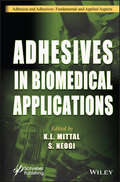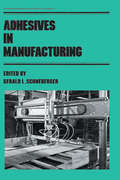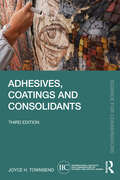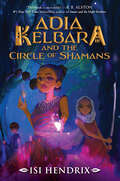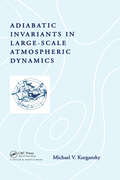- Table View
- List View
Adhesion and Bonding in Composites
by Ryutoku YosomiyaThis book deals with the roles played by the component material interface in composites, with special emphasis on methods used to improve the adhesion and bonding between them. It is helpful for scientists and engineers in the materials field and to engineers working with adhesives or composites.
Adhesion in Foods: Fundamental Principles and Applications
by Amos NussinovitchTo the layman, adhesion is a simple matter of how well two different materials stick together, and adhesion measurements provide some indication of the force required to separate them. However, a more detailed look at adhesion shows that it is a very important feature of food throughout its manufacturing, packaging and storage. Chapters are fully devoted to the fascinating topic of adhesion in foods. Key features of the book include, but are not limited to: definition and nomenclature of adhesion; adhesion mechanisms and measurements; stickiness in various foods and its relation to technological processes; perception of stickiness; hydrocolloids as adhesive agents for foods; adhesion phenomena in coated, battered, breaded and fried foods; electrostatic adhesion in foods; multilayered adhered food products, and adhesion of substances to packaging and cookware. Adhesion in Foods: Fundamental Principles and Applications is dedicated not only to the academic community but also to the broader population of industrialists and experimentalists who will find it to be not only a source of knowledge, but also a launching pad for novel ideas and inventions. In particular, this book is expected to be of interest to personnel involved in food formulation, food scientists, food technologists, industrial chemists and engineers, and those working in product development.
Adhesion in Layered Cement Composites
by Łukasz SadowskiThis book discusses how to identify the level of adhesion in layered systems made of cement composites using a multi-scale approach based on experimental and numerical analyses. In particular, it explains <p><p> 1. The suitability of previously used artificial intelligence tools and learning algorithms for reliable assessment of the level of adhesion of layered systems made of cement composites based on non-destructive tests <p> 2. The development of the methodology for a reliable non-destructive evaluation of the level of adhesion in newly constructed layered systems of any overlay thickness and in existing layered systems made of cement composites <p> 3. How to determine whether to assess the level of adhesion of the layered systems, and discusses the amplitude parameters, spatial, hybrid and volume parameters describing the morphology of the concrete substrate surface in the mesoscale <p> 4. How to ascertain whether the effective surface area of the existing concrete substrate and the contribution of the exposed aggregate on this substrate, determined in mesoscale, have an impact on the level of adhesion of layered systems made of cement composites <p> 5. The assessment of the structure of air pores in the microscale and the chemical composition of the cement composite on the nanoscale in the interphase zone together with the determination of their impact on the level of adhesion of layered systems made of cement composites <p> 6. The development of an effective methodology for testing the level of adhesion of layered systems made of cement composites in a multi-scale approach, including the research methods and descriptors used.
Adhesion in Microelectronics
by K. L. Mittal Tanweer AhsanThis comprehensive book will provide both fundamental and applied aspects of adhesion pertaining to microelectronics in a single and easily accessible source. Among the topics to be covered include; Various theories or mechanisms of adhesion Surface (physical or chemical) characterization of materials as it pertains to adhesion Surface cleaning as it pertains to adhesion Ways to improve adhesion Unraveling of interfacial interactions using an array of pertinent techniques Characterization of interfaces / interphases Polymer-polymer adhesion Metal-polymer adhesion (metallized polymers) Polymer adhesion to various substrates Adhesion of thin films Adhesion of underfills Adhesion of molding compounds Adhesion of different dielectric materials Delamination and reliability issues in packaged devices Interface mechanics and crack propagation Adhesion measurement of thin films and coatings
Adhesion in Pharmaceutical, Biomedical, and Dental Fields
by K. L. Mittal F. M EtzlerThe phenomenon of adhesion is of cardinal importance in the pharmaceutical, biomedical and dental fields. A few eclectic examples will suffice to underscore the importance/relevance of adhesion in these three areas. For example, the adhesion between powdered solids is of crucial importance in tablet manufacture. The interaction between biodevices (e.g., stents, bio-implants) and body environment dictates the performance of such devices, and there is burgeoning research activity in modifying the surfaces of such implements to render them compatible with bodily components. In the field of dentistry, the modern trend is to shift from retaining of restorative materials by mechanical interlocking to adhesive bonding. This unique book addresses all these three areas in an easily accessible single source. The book contains 15 chapters written by leading experts and is divided into four parts: General Topics; Adhesion in Pharmaceutical Field; Adhesion in Biomedical Field; and Adhesion in Dental Field. The topics covered include: - Theories or mechanisms of adhesion.- Wettability of powders.- Role of surface free energy in tablet strength and powder flow behavior.- Mucoadhesive polymers for drug delivery systems. - Transdermal patches. - Skin adhesion in long-wear cosmetics. - Factors affecting microbial adhesion. - Biofouling and ways to mitigate it. - Adhesion of coatings on surgical tools and bio-implants. - Adhesion in fabrication of microarrays in clinical diagnostics. - Antibacterial polymers for dental adhesives and composites. - Evolution of dental adhesives. - Testing of dental adhesives joints.
Adhesion of Cells, Viruses and Nanoparticles
by Kevin Kendall Florian Rehfeldt Michaela Kendall"Adhesion of Cells, Viruses and Nanoparticles" describes the adhesion of cells, viruses and nanoparticles starting from the basic principles of adhesion science, familiar to postgraduates, and leading on to recent research results. The underlying theory is that of van der Waals forces acting between cells and substrates, embodied in the molecules lying at the surfaces, together with the geometry and elasticity of the materials involved. The first part describes the fundamental background to adhesion principles, including the phenomenology, the important equations and the modeling ideas. Then the mechanisms of adhesion are explored in the second part, including the elastic deformations of spheres and the importance of the energy of adhesion as measured in various tests. It is demonstrated that adhesion of cells is statistical and depends on Brownian movement and on the complex multiple contacts that can form as cells move around. Then, detailed chapters on cell adhesion, contact of viruses and aggregation of nanoparticles follow in Part 3. Finally, the last chapter looks to the future understanding of cell adhesion and points out some interesting directions of research, development and treatment of diseases related to these phenomena. This book is an ideal resource for researchers on adhesion molecules, receptors, cell and tissue culturing, virus infection, toxicity of nanoparticles and bioreactor fouling. It can also be used to support undergraduate and Masters level teaching courses. "This is a fascinating book and it is an invaluable resource for understanding particle-particle/surface adhesion at micro- and nano- scales. I intend to keep one for my future reference and highly recommend it to my students." (Prof. Zhibing Zhang, School of Chemical Engineering, University of Birmingham, UK)
Adhesive Bonding Technology and Testing
by Lucas Filipe da Silva Alireza Akhavan-Safar Ana Sofia Queiros Ferreira Barbosa Ricardo Joao Camilo Carbas Eduardo Andre Sousa MarquesAdhesive Bonding Technology and Testing Comprehensive resource that provides insight into the purpose and design of experiments for adhesive bonding, joint design and strength prediction This book provides support for those practicing and teaching adhesive bonding and enables them to understand and design laboratorial courses and experiments. To aid in reader comprehension and information retention, a selected set of problems with corresponding solutions is included, which helps readers to develop a deep understanding of the subject matter. Written by five highly qualified professionals in the field of adhesive bonding, sample topics covered in the book include: Practical demonstrations of adhesive bonding, plus discussion on the advantages and disadvantages of the technique Detailed laboratorial activities that pertain to adhesive bonding The manufacturing of defect-free bonded joints The effects of geometry and materials properties in adhesive joint testing, surface preparation, joint design, and strength prediction This book is an essential resource for chemists, engineers, and students/instructors in related programs of study who wish to conduct better and more efficient experiments that pertain to adhesive bonding and related concepts.
Adhesive Bonding in Five Steps: Achieving Safe and High-Quality Bonds
by Jürgen KlingenA comprehensive guide to successfully complete any adhesive bonding project In Adhesive Bonding in Five Steps: Achieving Safe and High Quality Bonds, accomplished chemist Dr. Jürgen Klingen delivers a thorough and practical overview of the adhesive concepts necessary for readers to design and sketch foundational steps in projects involving adhesive bonding. Readers will learn the complex considerations necessary for a successful adhesive bonding process from inception to completion. Dividing the adhesive bonding project into five clearly defined phases—planning, substrate concept, adhesive concept, feasibility, and development—the author demonstrates how to adhere to quality requirements while completing the reader’s own adhesive bonding processes. The book focuses on the treatment of the material surfaces to be bonded, the selection of suitable adhesives, the dimensioning of the bond, and the process steps for metering/mixing and curing the adhesives. The book also offers: A thorough introduction to the art and science of adhesive bonding, including adhesives, adhesive bonds, bonding in industry and craft, and an example of adhesive bonding in nature Comprehensive explorations of the history of adhesive bonding technology and wetting, adhesion, and cohesion Practical discussions of the necessary steps to achieving safe and high-quality adhesive bonds, including gate reviews and the DIN 2304 In-depth examinations of contemporary adhesive bonding applications, including examples in lightweight construction, modern façade construction, and low-energy plastics Perfect for engineers, engineering scientists, polymer chemists, and process engineers, Adhesive Bonding in Five Steps: Achieving Safe and High Quality Bonds will also prove to be an invaluable addition to the libraries of materials scientists and surface chemists.
Adhesive Bonding of Aircraft Composite Structures: Non-destructive Testing and Quality Assurance Concepts
by Konstantinos Tserpes Welchy Leite Cavalcanti Kai Brune Michael Noeske Wiesław M. Ostachowicz Mareike SchlagThis book is open access under a CC BY 4.0 license. It presents the results of the ComBoNDT European project, which aimed at the development of more secure, time- and cost-saving extended non-destructive inspection tools for carbon fiber reinforced plastics, adhered surfaces and bonded joints. The book reports the optimal use of composite materials to allow weight savings, reduction in fuel consumptions, savings during production and higher cost efficiency for ground operations.
Adhesive Bonding of Aluminum Alloys
by ThrallThis single-source reference is designed for anyone who is responsible for selecting the bestsurface treatment and a compatible adhesive for a particular design.Filled with over 300 photos, figures, and tables, Adhesive Bonding of Aluminum Alloyspresents clear analytical methods for examining the adequacy of bonded joints ... methodsfor chemical analysis of an adhesive and primer ... specific instructions on how to anodizealuminum alloys for three different surface treatments .. . recommended primers foranodized alloys ... examples that help you verify fail-safe capacity ... and more.In addition, this guide gives you the latest chemical analysis methods for control, proventest procedures for mechanical durability properties, a wide selection of nondestructive inspectionprocedures, and numerous surface analysis methods.Adhesive Bonding of Aluminum Alloys can be of immediate assistance to materials, mechanical,design, process, manufacturing, automotive, aeronautical, corrosion, and maintenanceengineers; designers and manufacturers of primary and secondary aluminum structures;adhesive scientists; testing and material specialists; and upper-division undergraduateand graduate-level researchers in materials, aeronautical design, and adhesive science.
Adhesive Interactions in Normal and Transformed Cells
by Yury A. RovenskyAdhesive Interactions in Normal and Transformed Cells describes the basic mechanisms of the ability of tissue cells to attach to each other and to the extracellular matrix. These adhesive interactions are pivotal regulators of main cellular functions, such as proliferation, survival and migration. The adhesive interactions are involved in embryonic development, regeneration, and also in inflammation and degeneration processes, which are at the basis of many diseases. Serious alterations in cell adhesion caused by the oncogenic transformation play a key role in cancer invasion and metastasis. This volume provides comprehensive information about structural, mechanistic and signaling aspects of adhesive interactions in both normal and cancer cells in comparison. Integration of such aspects of the adhesive process as structure, relation to cell systems of receptors and cytoskeleton, function, signaling pathways, and the alterations in tumor cells constitutes the strongest point of this work. The results of the long-time author's research are included in the book. The author was one of pioneers, who used scanning electron microscopy (SEM) to study the cell surface morphology of normal cultured cells and the cells underwent the oncogenic transformation, processes of their attachment to and spreading on the surfaces of a solid substratum, and also surprising ability of the cells to respond to various geometric configurations of the substrata surfaces. Adhesive Interactions in Normal and Transformed Cells has both biological and medical aspects and, therefore, it can be interesting not only for cell biologists, developmental biologists and cancer researchers, but also for physicians. It is intended for researchers, postdocs, undergraduate and graduate students.
Adhesive Interactions of Mussel Foot Proteins (Springer Theses)
by Jing YuWater and moisture undermine strong adhesion to polar surfaces. Marine mussels, however, achieve durable underwater adhesion using a suite of proteins that are peculiar in having high levels of 3, 4-dihydroxyphenylalanine (Dopa). Mussel adhesion has inspired numerous studies on developing the next generation of wet adhesives. This thesis presents recent progress in understanding the basic surface and intermolecular interactions employed by mussels to achieve strong and durable wet adhesion. The surface forces apparatus (SFA) and various other techniques were applied to measure the interactions between mussel foot protein-3 fast (Mfp-3 fast) and the model substrate, mica, as well as the interactions between various mussel adhesive proteins The results in this thesis show that Dopa plays an essential role in mussel adhesion and that mussels delicately control the interfacial redox environment to achieve strong and durable Dopa mediated adhesion. The interplay between Dopa and hydrophobic interactions is also evident in mussel adhesion.
Adhesive Joints: Ageing and Durability of Epoxies and Polyurethanes
by Wulff Possart Markus BredeA comprehensive overview of adhesive bonding, providing both basic knowledge of polymer adhesives as well as insights into their mechanical and ageing properties. The book is unique in its up-to-date, self-contained summary of recent developments and in its integration of the theory, synthesis and mechanical properties of adhesive joints as well as their applications. Well-structured throughout, the first chapter introduces the initial state of adhesive joints and their formation, while subsequent chapters discuss the ageing and failure as well as the weathering of adhesive joints. In addition the issue of long-term behavior and lifetime predictions are considered. The text is rounded off by a look at future technological advances. The result is an essential reference for a wide range of disciplines
Adhesive Joints: Volume 2
by K. L. MittalThis volume documents the proceedings of the Second International Symposium on Adhesive Joints: Formation, Characteristics and Testing held in Newark, NJ, May 22-24, 2000. Since the first symposium, held in 1982, there had been tremendous research activity dealing with many aspects of adhesive joints.This volume contains a total of 21 papers, which were all properly peer reviewed, revised and edited before inclusion. Therefore, this book is not merely a collection of unreviewed manuscripts, but rather represents information which has passed peer scrutiny. Furthermore, the authors were asked to update their manuscripts, so the information contained in this book should be current and fresh.The book is divided into three parts: 1) General Papers; 2) Evaluation, Analysis and Testing; and 3) Durability Aspects. The topics covered include: molecular brush concepts in enhancing strength of adhesive joints; factors affecting performance of adhesive joints; substrate preparation and modification; interfacial/interphasial aspects; determination of locus of failure; analysis and evaluation of adhesive joints using various techniques; testing of adhesive joints; stress analysis; application of fracture mechanics; durability aspects; accelerated environmental degradation of adhesive joints; solvent uptake; and adhesives with special characteristics.This volume represents a commentary on the current R&D activity in this arena and it should be of great value and interest to anyone interested in adhesive bonding / adhesive joints. Furthermore, this volume contains a number of excellent review/overview articles, which should be of particular value.
Adhesive Particle Flow
by Jeffrey S. Marshall Shuiqing LiOffering a comprehensive treatment of adhesive particle flows, this book adopts a particle-level approach oriented toward directly simulating the various fluid, electric field, collision, and adhesion forces and torques acting on the particles, within the framework of a discrete-element model. It is ideal for professionals and graduate students working in engineering and atmospheric and condensed matter physics, materials science, environmental science, and other disciplines where particulate flows have a significant role. The presentation is applicable to a wide range of flow fields, including aerosols, colloids, fluidized beds, and granular flows. It describes both physical models of the various forces and torques on the particles as well as practical aspects necessary for efficient implementation of these models in a computational framework.
Adhesives and Finishes for Wood: For Practitioners and Students
by Moon G. KimAdhesives and Finishes for Wood Understand the science of joining wood with this comprehensive guide Long seen as an old-fashioned material with narrowing modern applications, wood has seen increased popularity as a material in building and manufacturing in recent years. This has been driven by the need for sustainable resources and environmentally friendly materials. As a result of increased emphasis on wood, however, there is a corresponding need to understand the wood adhesives, the crucial materials in wood-based manufacture and craftsmanship. Adhesives and Finishes for Wood meets this need with a comprehensive but accessible introduction to the chemistry and applications of wood adhesives. Its easy-to-follow presentation nonetheless presents wood adhesives and finishes in significant detail. Ideal for readers without considerable preexisting knowledge in chemistry, this book includes everything the reader needs to understand and apply wood adhesives in their work or industry. Adhesives and Finishes for Wood readers will also find: Coverage ranging from the fundamentals of wood adhesive polymer chemistry to the properties of specific wood structures and resins A presentation suitable for both academic students and wood manufacture professionals An author with decades of experience in both academia and industry Adhesives and Finishes for Wood is a useful reference for advanced students and professionals in industries or manufacturing disciplines that incorporate wood, as well as for chemists, materials scientists, vocational school instructors, and more.
Adhesives for Wood and Lignocellulosic Materials
by R. N. Kumar A. PizziThe book is a comprehensive treatment of the subject covering a wide range of subjects uniquely available in a single source for the first time. A material science approach has been adopted in dealing with wood adhesion and adhesives. The approach of the authors was to bring out hierarchical cellular and porous characteristics of wood with polymeric cell wall structure, along with the associated non-cell wall extractives, which greatly influence the interaction of wood substrate with polymeric adhesives in a very unique manner not existent in the case of other adherends. Environmental aspects, in particular formaldehyde emission from adhesive bonded wood products, has been included. A significant feature of the book is the inclusion of polymeric matrix materials for wood polymer composites.
Adhesives in Biomedical Applications (Adhesion and Adhesives: Fundamental and Applied Aspects)
by K. L. Mittal S. NeogiADHESIVES IN BIOMEDICAL APPLICATIONS Uniquely provides up-to-date and comprehensive information on adhesives in biomedical applications in an easily accessible form. Adhesives are gaining popularity in many and varied biomedical applications as they are being used as a replacement for sutures and staples, which have the disadvantages such as scarring, infection, keloid formation, poor skin healing, or hernia in the case of abdominal sutures. On the other hand, adhesives dramatically reduce healthcare costs, significantly reduce time spent in surgery, curb the risks of bleeding, and are generally easy to use. Adhesives also find their use in diagnostic imaging, various biomedical devices, dental adhesives, dermal adhesives, etc. Adhesives in Biomedical Applications contains eleven chapters and is divided into two parts: Part 1: General Topics; and Part 2: Specific Adhesives, Characteristics, and Applications. Topics covered include: historical developments of various adhesives for biomedical applications; global industry development and analysis of adhesives for biomedical applications; biomedical adhesives; bioadhesion: fundamentals and mechanisms; fibrin glue; herbal bioactives-based mucoadhesive drug delivery systems; adhesive hydrogels; adhesives in dermal patches; medical adhesives from extracted mussel adhesive proteins; dental adhesives; and the role of adhesive-based systems for diagnostic imaging and theranostic applications. Audience The book will be used by adhesionists, adhesive technologists, polymer scientists, materials scientists, as well as those involved with biomedical devices and bioimplants such as medical doctors, surgeons, cosmetologists, as well as engineers in the pharmaceutical industry.
Adhesives in Manufacturing
by SchnebergerThis book provides an exhaustive range of detailed, easy-access information required to initiate or improve an adhesive bonding operation in a modern industrial environment. Featuring recent developments and more than 400 photos, figures, and tables, this practical reference is the most comprehensive up-to-date book available. Designed for engineers and technicians confronting everyday problems of selections, surface preparation, applications, and curing, this book progresses from fundamental concepts to all types of adhesives, bonding techniques, and performance, durability, and testing of bonds, including such areas as acrylic and urethan adhesives, and water-based systems.
Adhesives, Coatings and Consolidants (Science for Conservators)
by Joyce H. TownsendThis new edition titled Adhesives, Coatings and Consolidants discusses the chemical, physical, and optical properties that influence the selection of adhesives, coatings, and consolidants used in the conservation of cultural heritage objects made from a wide range of materials.The structured text guides readers through the concepts that underpin the selection of the material to use for a given object, when making a join, applying a coating, or consolidating a fragile surface. Widely used conservation materials today are mentioned in the context of the desirable properties that account for their popularity, while examples of those used in the past and likely to be found on previously treated objects are also discussed. This volume is not a recipe book. It is a basic primer and an aid to the assimilation of concepts that will become embedded in decision-making by conservation professionals. Adhesives are discussed first and in the most detail, followed by coatings. The section on consolidants has been extended to reflect developments in treatment and ongoing research into more effective and more sustainable products, such as nanomaterials, that offer new possibilities for the treatment of challenging objects. A list of further reading and some practical exercises are included, along with a comprehensive index.Thoroughly updated to reflect the most recent research, Adhesives, Coatings and Consolidants remains a crucial resource for those beginning a course of study in practical conservation and as a refresher for emerging and mid-career conservators.
Adhunik Bharat KA Samajik Itihas
by Ravinder Kumar Aditya Narayan SinghThe book tells about the vast national movement as the most improtant historical process, establishment of independent states. The rise of nationalism in India and its success is a historical event of significance.
Adi Shankaracharya_ Hinduism's Greatest Thinker - Pavan K Varma: Hinduism's Greatest Thinker
by Pavan K. VarmaWhat is Brahman? What is its relationship to Atman? What is an individual’s place in the cosmos? Is a personalised god and ritualistic worship the only path to attain moksha? Does caste matter when a human is engaging with the metaphysical world? The answers to these perennial questions sparkle with clarity in this seminal account of a man, and a saint, who revived Hinduism and gave to Upanishadic insights a rigorously structured and sublimely appealing philosophy. Jagad Guru Adi Shankaracharya (788–820 CE) was born in Kerala and died in Kedarnath, traversing the length of India in his search for the ultimate truth. In a short life of thirty-two years, Shankaracharya not only revived Hinduism, but also created the organisational structure for its perpetuation through the mathas he established in Sringeri, Dwaraka, Puri, and Joshimatha. Adi Shankaracharaya: Hinduism’s Greatest Thinker is a meticulously researched and comprehensive account of his life and philosophy. Highly readable, and including a select anthology of Shankaracharya’s seminal writing, the book also examines the startling endorsement that contemporary science is giving to his ideas today. A must-read for people across the ideological spectrum, this book reminds readers about the remarkable philosophical underpinning of Hinduism, making it one of the most vibrant religions in the world.
Adia Kelbara and the Circle of Shamans (Adia Kelbara and the Circle of Shamans)
by Isi HendrixThe first book in a fast-paced, witty, and big-hearted debut Afrofantasy trilogy about a twelve-year-old apprenticing in the kitchens at the prestigious Academy of Shamans, who must ally with a snarky goddess and a knife-wielding warrior to save her kingdom. Perfect for fans of Amari and the Night Brothers and The School for Good and Evil.Life is tough for twelve-year-old orphan Adia. Her aunt and uncle believe she’s an ogbanje, a demon-possessed child that brings misfortune wherever they go, and Adia can’t disagree—especially when she suddenly manifests mysterious powers that she can’t control, causing an earthquake in her village.So when Adia is offered a kitchen apprenticeship at the faraway Academy of Shamans, she flees with nothing but a pouch of change, her cat Bubbles, and the hope that someone there can figure out what's wrong with her—and fix it. But just as she's settling in, Adia stumbles upon a shocking secret: Unlike her, the kingdom's emperor really is possessed—by a demon more wicked than any other. And he’s on his way to the Academy for a visit.Joining forces with a snarky goddess, a 500-year-old warrior girl, and an annoying soldier-in-training, Adia must travel through hidden realms to exorcise the emperor and save her kingdom. But to succeed, she first must come to understand the powers inside her….The fate of the world hangs in the balance.
Adia Kelbara and the High Queen's Tomb (Adia Kelbara and the Circle of Shamans)
by Isi HendrixThe second book in a fast-paced, witty, and bighearted debut Afrofantasy trilogy about a twelve-year-old apprentice in the kitchens at the prestigious Academy of Shamans who must ally with a snarky goddess and a knife-wielding warrior to save her kingdom. Perfect for fans of Amari and the Night Brothers and The School for Good and Evil!Adia Kelbara may have defeated the power-hungry god Olark and saved Zaria, but now she must face something even more terrifying: her first semester as a student at the Academy of Shamans. As her abilities are tested during orientation, a mysterious affliction causes everyone except for Adia and Thyme to pass out—and a reanimated corpse appears, with a horrifying message.As if that wasn’t bad enough, Emperor Darian sends news that the same phenomenon is happening across the kingdom and that someone is siphoning energy from the living to resurrect corpses, creating cracks between the realms of the living and the dead.Now it will be up to Adia to push her powers to their limit and journey to the tomb of the ancient High Queen in search of answers and a cure for the sleeping sickness besieging Zaria. But rising corpses aren’t the only threats that stand in her way—a new enemy looms, and if Adia can’t defeat them, Zaria may soon become another realm of the dead.
Adiabatic Invariants in Large-Scale Atmospheric Dynamics
by Michael V. KurganskyAdiabatic Invariants in Large-Scale Atmospheric Dynamics deals with the main principles of large-scale atmospheric dynamics on the basis of adiabatic motion constants. It introduces the theory of quasi two-dimensional fluid motion, concentrating primarily on nearly horizontal fluid parcel displacements in a stably stratified compressible fluid. Coverage also includes a complete set of compressible fluid dynamic equations along with a survey of fluid dynamical conservation laws used in meteorology and atmospheric physics; the derivation of two-dimensional atmospheric models; and the principles of kinetic energy sinks and their relation to the energy balance in the atmosphere.


